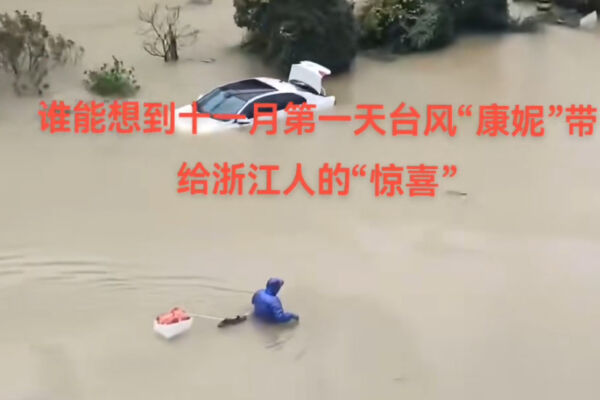On the afternoon of November 1st, Typhoon Connie (Kangni in Chinese) grazed the coast of Wenling in Zhejiang Province and headed northwards, before turning northeastward and gradually weakening in intensity. However, the outer cloud system of Typhoon Connie continued to bring heavy rain to the southeastern coastal areas, leading to flooding in 14 rivers in Zhejiang, Fujian, Jiangsu, and trapping a mother and daughter in Shanghai.
According to the meteorological department’s forecast, due to the influence of cold air and Typhoon Connie, from November 1st to 2nd, there will be strong winds of force 6 to 7 in the Hangzhou Bay, the coastal areas of Jiangsu, Shanghai, and Zhejiang, with heavy to torrential rain in northeastern Zhejiang, Shanghai, and southeastern Jiangsu, and locally extremely heavy rain.
As of 3:00 pm on the 1st, Pingyang in Zhejiang received 253.2 mm of rainfall, breaking the record for the latest extremely heavy rain in local observation history. Xu Jiahui in Shanghai, Ningbo, Shaoxing, and Zhoushan in Zhejiang, as well as Changzhou in Jiangsu, also broke records for the latest heavy rain in local meteorological records.
According to the Shanghai Meteorological Bureau, due to the rainfall, 6.0% of the townships in Shanghai received over 100.0 mm of rainfall, with 59.5% receiving over 50.0 mm, and the highest precipitation recorded in Pudong Laogang Township at 126.1 mm, with the highest hourly rainfall recorded in Fengxian Sizhuan Township at 40.0 mm.
Reportedly by The Paper, a mother and daughter in Sanlin Town, Pudong New Area, Shanghai, experienced flooding in their home, with floodwaters reaching up to 75 cm outside their door, trapping them momentarily.
An online video showed a glass door of a building in Shanghai being shattered by strong winds, with cleaning staff seen clearing up the broken glass on site.
Moreover, Suzhou River almost burst its banks yesterday noon. Videos taken by netizens showed that at the section near Zapu Road Bridge, the water nearly completely blocked the bridge arch, while some waterfront platforms near Wuning Road Bridge and Tian’an Qianshu were submerged. Suzhou River and Huangpu River sluice gates were opened for drainage.
Citing information from the Ministry of Water Resources, apart from the Suzhou River in Shanghai, 14 rivers including the Yongxin River, Zhuyouxixi in coastal Zhejiang, Minbei River in eastern Fujian, and Tongyang Canal in Jiangsu have exceeded their flood warning levels due to the precipitation from Typhoon Connie. Thirteen monitoring points around Taihu Lake saw water levels exceeding warnings, as did 6 coastal tide gauge stations in Fujian, Zhejiang, and Shanghai. Netizens reported, “They said the seawall in Cixi City, Zhejiang Province, is draining by opening the gates.”
Affected by Typhoon Connie, as of 9:00 am on the 1st of November, Zhejiang Province evacuated a total of 282,000 people, and water transportation ferries and boats were suspended, as were all ongoing water-related construction projects. 675 construction vessels were relocated to sheltered areas. Hangzhou Airport canceled 70 flights, and Wenzhou Airport canceled 67 flights. Additionally, in Wenzhou and Taizhou, primary and secondary schools and kindergartens suspended classes for the day on the 1st.
In Fujian, on October 31st, strong winds caused solar panels to be blown off and roofs to collapse.
According to the forecast, Typhoon Connie has gradually moved away from the coast of Zhejiang. It is predicted that there will still be heavy rainfall in Jiangsu, Shanghai, Zhejiang, and Yunnan on the 3rd.

